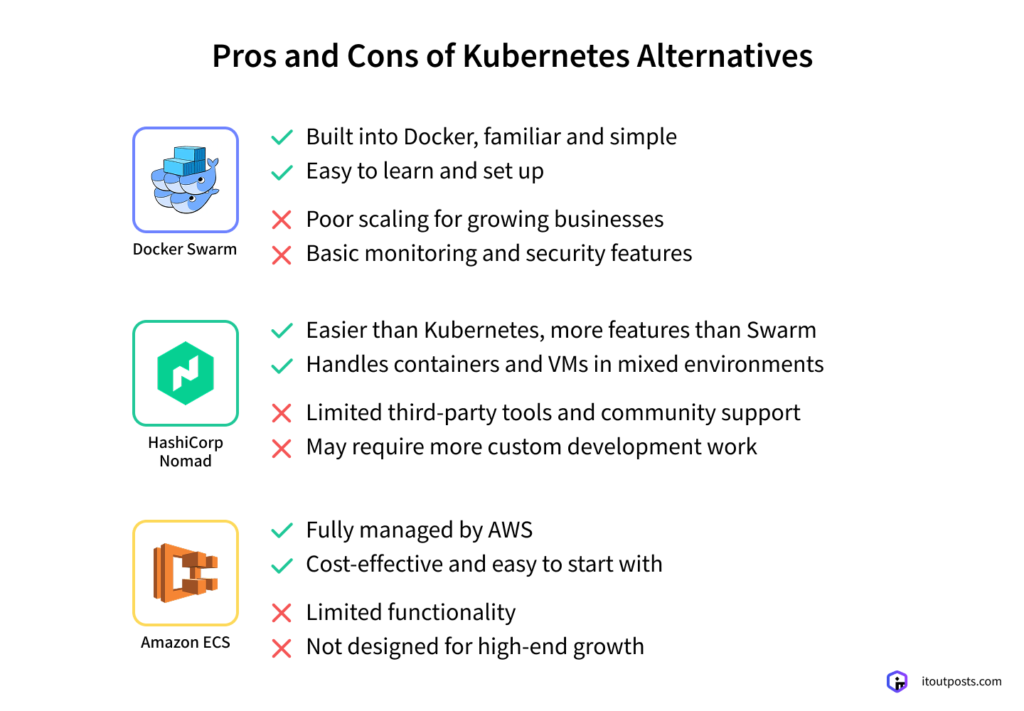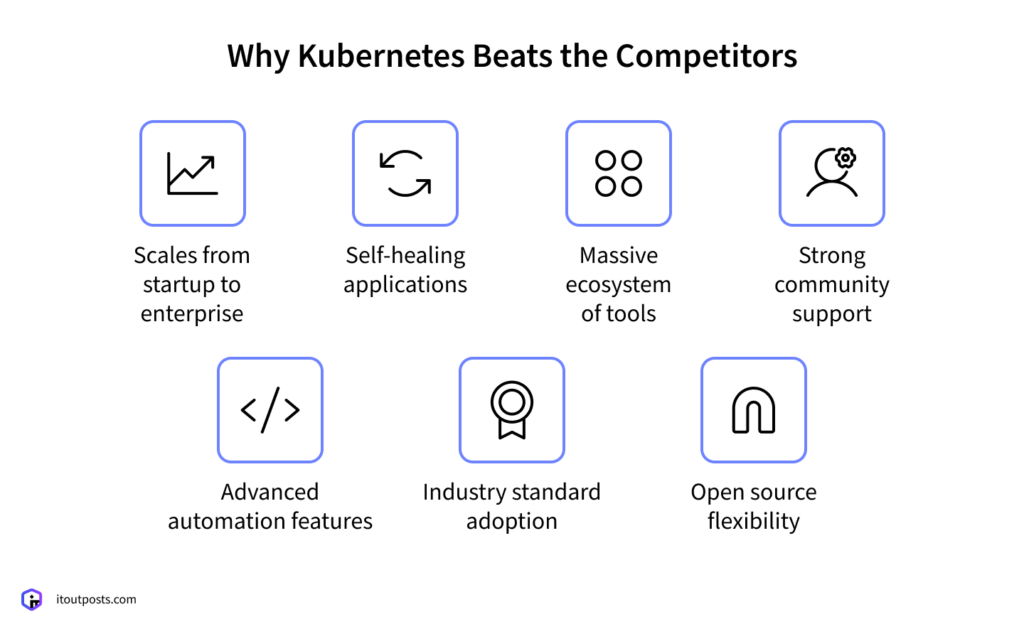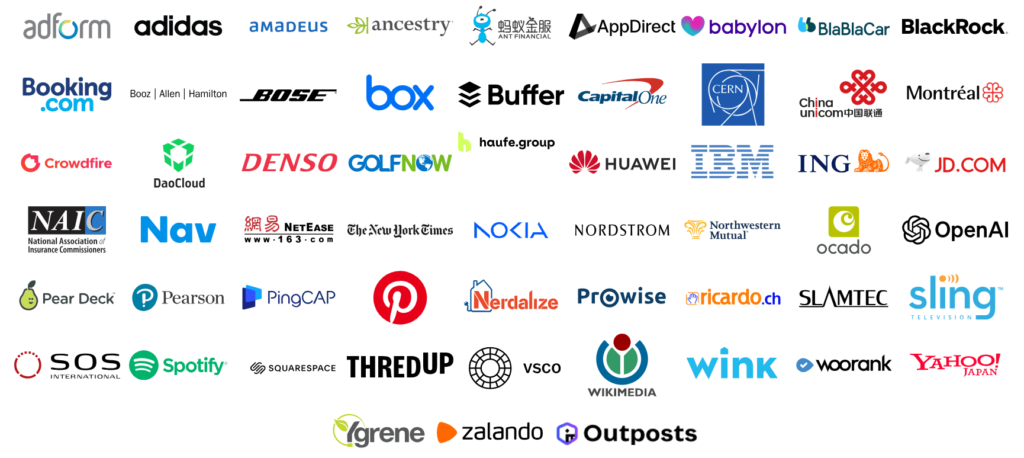Contents
The majority of applications that have become part of our daily routine are available whenever we need them, loading instantly as we tap their icons. And it’s not because this is just how software is supposed to behave once it’s built.
Such apps are likely powered by Kubernetes. It handles the complex tasks behind the scenes while you scroll through Netflix, stream Spotify, or book your next trip on Airbnb.
Kubernetes allows you to put app management on autopilot, standardizes processes, and frees teams to focus on building and iterating. And not only that.
Let’s explore what Kubernetes does and what its adoption means for the business bottom line.
What Is Kubernetes?
Kubernetes, often called K8s (because the “8” represents the eight letters between “K” and “s”), is an open-source container orchestration system. Its logo features a ship’s wheel, and that’s exactly what Kubernetes does for you: charts the course for your containerized applications.
Kubernetes Alternatives
At IT Outposts, we consider Kubernetes the clear leader when it comes to container orchestration. But to understand why we prefer it, let’s take a quick look at some of its alternatives and what they bring to the table:
- Docker Swarm. If you have a few individual Docker servers, Docker Swarm lets you connect them, so they act like one big server. It’s built right into Docker, and you’ll find Swarm incredibly familiar and simple to pick up. Yet, Swarm doesn’t scale well as your business grows and provides basic monitoring and security features compared to Kubernetes.
- HashiCorp Nomad. This solution serves as a middle ground — a tool that’s easier to use than Kubernetes but offers more features than Docker Swarm. It’s ideal for organizations looking for a powerful yet user-friendly way to manage diverse applications, like containers and virtual machines, especially in mixed environments like on-premises and the cloud. However, Nomad doesn’t have the extensive range of third-party tools and community support that Kubernetes provides, so companies might need to invest more in their own development to meet specific needs.
- Amazon Elastic Container Service (ECS). This is a fully managed service. What this means is that Amazon (AWS) owns and oversees the physical servers, the OS on those servers, and most of the networking and low-level settings. This makes ECS easier to master and more cost-effective at the beginning. But as you add more services, scaling becomes increasingly problematic because ECS was not designed for high-end growth.

Of course, these solutions are quite suitable for certain projects. Nevertheless, if you plan to scale your applications substantially and want the highest possible flexibility and control of your infrastructure, then we highly recommend Kubernetes, and here’s why.
What Makes Kubernetes So Special?
Kubernetes’ functionality determines its success in the first place. These are some of the core built-in capabilities that ensure your applications run reliably yet with minimal human intervention.

Self-Healing
Applications can fail at any time. A container might crash, become unresponsive, or an entire server could go down. Usually, someone would have to notice these problems and manually fix them.
Kubernetes, on the other hand, is designed with a “self-healing” ability. It constantly monitors your applications and the underlying infrastructure. If a piece of your application (a “container”) stops working, becomes unhealthy, or even if an entire server goes down, Kubernetes automatically detects the problem. It then intelligently restarts the unhealthy part, or moves your application to a healthy server without you lifting a finger.
Auto-Scaling (Up and Down)
Consider how a retail website experiences massive traffic spikes during a sale or holiday season, and then quiet periods afterward. Manually adding or removing servers and app instances to match this fluctuating demand is a time-consuming task.
Kubernetes offers auto-scaling. It can automatically increase the number of application copies and even the number of underlying servers when demand goes up, ensuring your customers always have a smooth experience.
Furthermore, it can also reduce resources when demand drops, so you don’t have to pay for expensive computing power that’s not needed.
Advanced Resource Management
Kubernetes also allows for much more precise control over how much CPU and memory each piece of your application needs and uses. And it goes way beyond just setting limits on how much each app can consume.
Kubernetes packs applications onto your servers to get the most out of your hardware investment. It can ensure critical applications always have the resources they need, while less critical ones might share what’s left.
What Else Makes Kubernetes the Industry Standard
Apart from its built-in features, Kubernetes has three advantages that have established its dominance in container orchestration.
The Open Source Advantage
Originally developed by Google, Kubernetes is open source. This means that everyone, from Google to Microsoft, Amazon, Red Hat, and many others, can contribute to its improvements. And this does lead to a lot of teamwork across the tech industry.
Thanks to such an unprecedented collaborative approach, Kubernetes evolves faster than closed-source options. Whenever a problem pops up, companies have the freedom to fix it themselves or hire someone else to do it. They don’t have to wait for vendor updates or until their particular feature request is processed.
Massive Ecosystem Support
When it comes to container orchestration, Kubernetes has established the biggest ecosystem possible. Almost every major cloud provider offers managed Kubernetes services, and hundreds of third-party tools can be integrated with it. Thus, when you choose Kubernetes, you become part of a huge community of tools, expertise, and services.
Battle-Tested by Tech Giants
Kubernetes serves the world’s largest organizations and their solutions, like Booking.com, OpenAI, Adidas, as well as previously mentioned Netflix, Spotify, and Airbnb. It can power both small startups and huge enterprises with millions of users.

Therefore, the platform has been thoroughly tested in real-world environments across many industries. This lets other organizations who consider adopting Kubernetes feel confident that it can support their growth, too.
What Kubernetes Means for Businesses
Technical details are good. But any tech decision must directly translate into business impact. So, here’s how Kubernetes tech capabilities can translate into benefits for your business.
Infrastructure Cost Predictability
With Kubernetes, you can set specific resource requests and limits for your apps. This means you define the minimum amount of CPU and memory your application needs, and the maximum it can use. With such clear boundaries, you know exactly how much each application costs to run.
Plus, Kubernetes can be smoothly integrated with numerous cost monitoring tools. These tools can track resource usage and spending down to individual applications or namespaces within your cluster. Using this data, you can detect patterns in your spending and make smarter choices to save on infrastructure costs in the future.
Risk Management
System failures can seriously affect a business’s bottom line. For instance, a major outage during peak season can lead to millions in lost revenue and permanent customer loss. Kubernetes significantly reduces these kinds of disasters thanks to its self-healing feature.
The platform also reduces deployment risks. You can push new features or fixes more often and with confidence because if something goes wrong, it automatically rolls back.
Customer Satisfaction and Retention
Last but not least, system reliability directly affects customer behavior. When systems are dependable, it shows in the business results.
For example, online stores tend to get more visitors to complete their purchases when their web pages stay quick and steady. Similarly, SaaS providers see fewer customers leaving when their apps stay accessible, even during busy times.
Plus, Kubernetes allows you to launch new features and fix bugs faster, which makes using your products a better experience overall. And this means happier customers who stay longer and keep coming back.
Top 3 Kubernetes Adoption Phobias: Named and Debunked
Not every organization has adopted Kubernetes yet. As we mentioned, some can be satisfied with simpler options like Docker Swarm or ECS.
However, many companies hesitate, not because their alternative works better for them, but because of deep-rooted fears and uncertainties about adopting Kubernetes. Let us list and debunk the main ones below.
Phobia #1: “It’s Too Complex for Our Team”
Some teams may be overwhelmed when they initially look through Kubernetes documentation, with lots of terms, like pods, ingress controllers, persistent volumes, and more. And it feels like there’s a lot to learn all at once.
The reality is more nuanced. Yes, Kubernetes has many components, but you don’t need to become an expert overnight. You can start with basic services, then gradually adopt advanced features as needed. As you get comfortable, you can slowly start exploring more advanced features.
On top of that, if you use managed Kubernetes services from cloud providers, like Amazon EKS, many of the heavy lifting, like security patches, are handled for you.
Phobia #2: “The Learning Curve Will Kill Our Productivity”
Some teams also worry that switching to Kubernetes will slow down their development for months, as everyone needs time to learn new concepts. It feels like this drop in productivity isn’t worth it, especially when their current systems work adequately.
But the truth is, you don’t have to pause your performance to make the switch. Most successful teams adopt Kubernetes gradually, starting by containerizing just one application, then gradually learning the basics with less critical workloads. Production deployments happen only after teams gain confidence with the platform.
Phobia #3: “It’s Too Expensive for Our Budget”
Also, organizations often assume Kubernetes will increase infrastructure costs. They see managed Kubernetes services charging extra fees and worry about the additional compute resources needed for cluster management.
While it’s true that managed Kubernetes services usually charge management fees, the savings you get from more efficient resource use tend to outweigh these costs. Kubernetes helps pack applications more tightly onto servers, which can mean needing fewer servers overall.
Get Kubernetes Up and Running in One Week
Kubernetes is a powerful container orchestration tool that scales with your needs. It works just as well for a small startup app as it does for complex enterprise systems. A smart choice is to start using Kubernetes right from the beginning. This way, you’ll avoid time-consuming migrations that often come when you outgrow simpler setups.
If you’re looking to build your infrastructure on Kubernetes but want to skip the lengthy setup process, we can help. Meet AMIX — our tried-and-true pre-built infrastructure solution.
We developed AMIX based on real experiences from over 50 successful projects, using proven DevOps methods with Kubernetes at the core.
Ready to skip the learning curve and start building? Contact us and get immediate access to AMIX at no cost!

I am an IT professional with over 10 years of experience. My career trajectory is closely tied to strategic business development, sales expansion, and the structuring of marketing strategies.
Throughout my journey, I have successfully executed and applied numerous strategic approaches that have driven business growth and fortified competitive positions. An integral part of my experience lies in effective business process management, which, in turn, facilitated the adept coordination of cross-functional teams and the attainment of remarkable outcomes.
I take pride in my contributions to the IT sector’s advancement and look forward to exchanging experiences and ideas with professionals who share my passion for innovation and success.